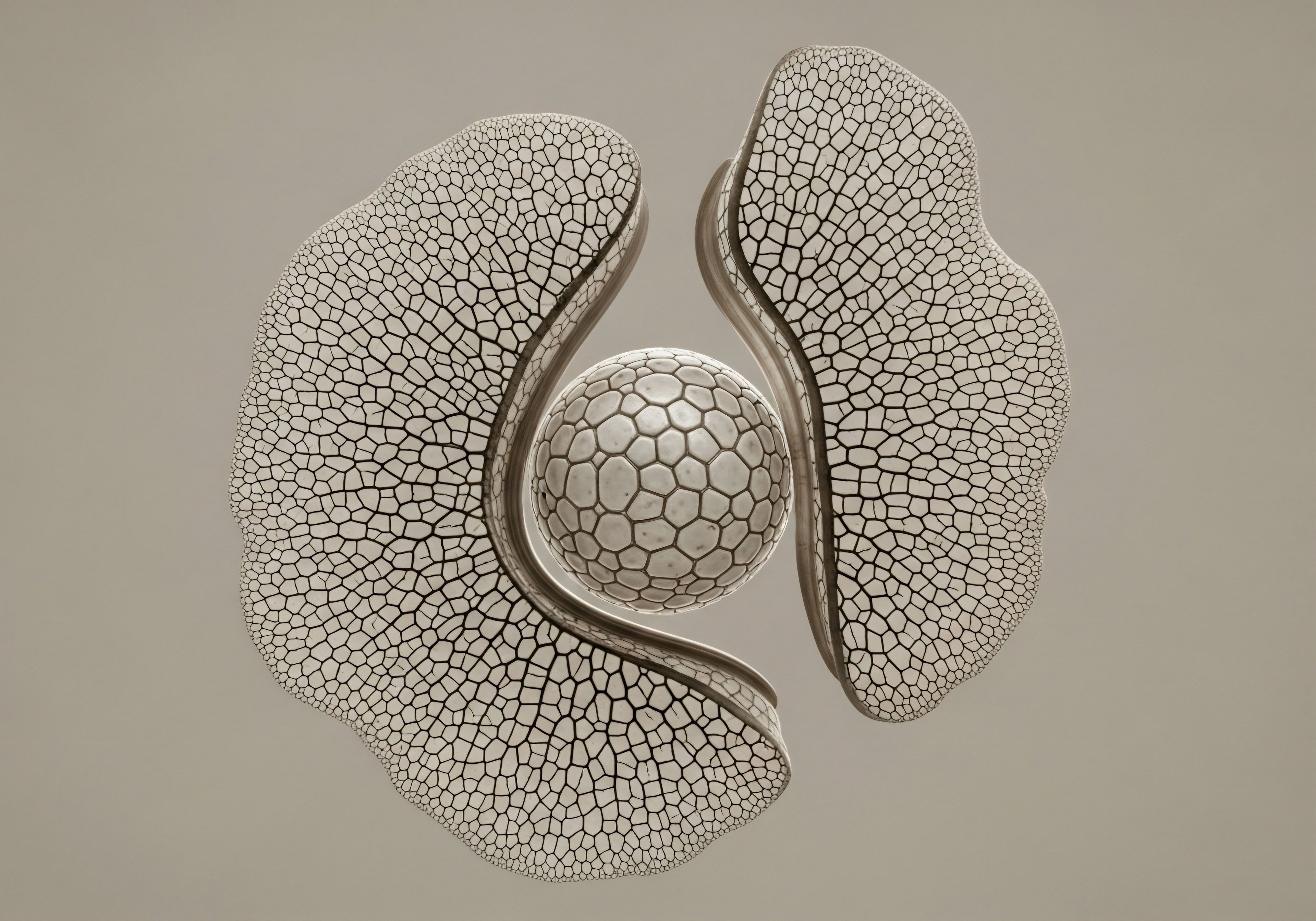

Fundamentals
The experience of lying awake, feeling the hours slip by while your body refuses to yield to rest, is a deeply personal and frustrating one. You may feel a profound sense of exhaustion that permeates your days, a cognitive fog that clouds your thinking, and a feeling that your own biology is working against you.
This experience is a valid and important signal from your body. It is a direct communication about the state of your internal environment. Sleep is an active, highly regulated biological process, orchestrated by a complex interplay of chemical messengers. When this internal communication system is disrupted, the consequences are felt not just at night, but in every aspect of your waking life.
At the center of this regulatory network is your endocrine system, the intricate web of glands that produces and secretes hormones. These hormones function as the body’s internal messaging service, carrying instructions that govern everything from your metabolism and mood to your reproductive cycles and, critically, your sleep-wake patterns.
When hormonal concentrations fluctuate, as they do during perimenopause, menopause, or andropause, the messages that control sleep can become scrambled. The result is the very real experience of fragmented, unrefreshing sleep. Understanding this connection is the first step toward reclaiming restorative rest.
Hormonal fluctuations directly disrupt the brain’s sleep-regulating centers, leading to the common experience of poor sleep quality during key life stages.

The Hormonal Basis of Sleep Architecture
Your sleep is not a monolithic state of unconsciousness. It is a structured sequence of different stages, each with a unique purpose, collectively known as sleep architecture. This architecture includes cycles of light sleep, deep slow-wave sleep, and Rapid Eye Movement (REM) sleep. Healthy sleep depends on cycling through these stages in an orderly and uninterrupted fashion. Hormones, particularly estrogen and progesterone, are powerful modulators of this architecture.
Estrogen plays a significant role in promoting REM sleep and helps regulate the body’s core temperature. During menopause, as estrogen levels decline, this temperature regulation can become unstable, leading to the sudden, intense heat of hot flashes and night sweats. These vasomotor symptoms are a primary cause of awakenings, shattering sleep continuity.
Progesterone, on the other hand, functions as a natural relaxant. It exerts a calming effect on the brain, making it easier to fall asleep and stay asleep. Its decline removes a key calming influence, contributing to feelings of restlessness and anxiety at night.

Why Does Hormonal Imbalance Affect Sleep so Profoundly?
The brain regions responsible for sleep are rich with receptors for estrogen and progesterone. When circulating levels of these hormones are stable and sufficient, they bind to these receptors and help maintain the delicate balance of neurotransmitters ∞ chemicals like serotonin and GABA ∞ that promote calm and facilitate the transition into sleep.
When hormone levels become low or erratic, this finely tuned system is destabilized. The result is a brain that is more easily aroused from sleep, more susceptible to anxiety, and less capable of completing the restorative cycles it needs to function optimally. This is a biological reality, a direct consequence of altered endocrine signaling within the central nervous system.


Intermediate
To comprehend how hormonal optimization protocols can improve sleep, we must examine the specific mechanisms of action for each key hormone. The goal of these therapies is to re-establish a more stable and youthful hormonal environment, thereby restoring the biological signals that govern restorative sleep. This process involves carefully selected hormone formulations and delivery methods tailored to an individual’s unique physiology and needs.
Hormone replacement therapy works by replenishing the specific hormones that have declined, directly counteracting the biological disruptions they cause. For instance, reintroducing estrogen helps stabilize thermoregulation in the hypothalamus, the brain’s thermostat. This stabilization directly reduces the frequency and intensity of vasomotor symptoms like night sweats, which are a major source of sleep fragmentation for menopausal women. Simultaneously, progesterone supplementation provides a powerful calming influence, directly enhancing the body’s ability to initiate and maintain sleep.

Protocols for Restoring Sleep
The clinical application of hormone therapy for sleep improvement is precise. It involves selecting the right type of hormone, the appropriate dose, and the optimal delivery system to mimic the body’s natural rhythms and achieve the desired physiological effect. The choice between different protocols depends on a person’s specific symptoms, health history, and hormonal profile.

The Synergistic Action of Estrogen and Progesterone
In female hormone balance protocols, estrogen and progesterone are often used together to powerful effect. Estrogen addresses the disruptive physical symptoms, while progesterone provides a direct sedative and anxiolytic benefit.
- Estrogen’s Role Estrogen therapy, particularly using bioidentical 17β-estradiol, helps to normalize the sleep cycle. It can increase time spent in REM sleep and reduce the time it takes to fall asleep. By mitigating hot flashes, it removes one of the most common physical interrupters of sleep.
- Progesterone’s Role Micronized progesterone is molecularly identical to the progesterone produced by the body. When taken orally, it is metabolized in the liver into allopregnanolone, a potent neurosteroid. Allopregnanolone binds to GABA-A receptors in the brain, the same receptors targeted by sedative medications, producing a natural calming effect that facilitates deep, uninterrupted sleep.
Micronized progesterone acts as a natural sleep aid by producing metabolites that calm the central nervous system.
The route of administration is also a key consideration. Transdermal estrogen (patches or gels) is often preferred as it bypasses the liver, providing a more stable and consistent release of hormones into the bloodstream. This steady state is highly effective for managing symptoms like night sweats. Oral micronized progesterone is typically taken at bedtime to leverage its sleep-promoting effects fully.
| Delivery Method | Mechanism and Characteristics | Impact on Sleep |
|---|---|---|
| Transdermal Patch/Gel |
Delivers estrogen directly through the skin into the bloodstream. Bypasses first-pass metabolism in the liver, providing stable hormone levels. |
Highly effective at reducing night sweats and hot flashes due to consistent hormone delivery. Considered superior for improving subjective sleep quality. |
| Oral Tablets |
Hormones are absorbed through the digestive system and metabolized by the liver. Can cause more fluctuations in hormone levels. |
Effective, but the transdermal route may be more beneficial for sleep. Oral micronized progesterone is uniquely beneficial due to its conversion to sleep-promoting metabolites. |
| Pellet Therapy |
Small pellets containing hormones (e.g. Testosterone) are inserted under the skin, releasing a steady dose over several months. |
Provides long-term, stable hormone levels that can support overall well-being and energy, indirectly contributing to better sleep patterns by addressing systemic hormonal decline. |

The Role of Testosterone in Sleep and Vitality
While often associated with male health, testosterone is a vital hormone for women as well, contributing to energy, mood, and libido. In both men and women, optimized testosterone levels support the maintenance of lean muscle mass, which can reduce the risk of obstructive sleep apnea, a condition where breathing repeatedly stops and starts during sleep.
For men undergoing Testosterone Replacement Therapy (TRT), the restoration of normal testosterone levels often leads to improved energy, reduced fatigue, and a greater sense of well-being, all of which contribute to a healthier sleep-wake cycle. Protocols often include weekly injections of Testosterone Cypionate, sometimes paired with agents like Gonadorelin or Anastrozole to maintain a balanced endocrine state.


Academic
A sophisticated analysis of hormone therapy’s impact on sleep requires moving beyond symptom management to the level of neuroendocrine science and clinical trial data. The relationship between hormones and sleep is bidirectional; hormonal shifts disrupt sleep, and poor sleep further dysregulates hormonal axes.
Hormone therapy intervenes in this cycle, and its efficacy can be measured through both subjective reports and objective polysomnography (PSG) data. A meta-analysis of fifteen randomized controlled trials provided significant insights into these effects, revealing that while hormone therapy consistently improves self-reported, subjective sleep quality, its effects on objective PSG measures are less pronounced.
This distinction is meaningful. Subjective improvement reflects a person’s lived experience ∞ feeling more rested, falling asleep faster, and waking less often. This is a clinically important outcome. The lack of major changes in PSG data suggests that the therapy may work by reducing the disruptive events (like hot flashes) that lead to arousals, rather than fundamentally altering the brain’s core sleep-generating mechanisms in a way that is measurable by standard PSG. The improvement in quality of life comes from the reduction of sleep fragmentation.
Clinical data shows that the primary benefit of hormone therapy on sleep stems from reducing disruptive events like night sweats, thereby improving sleep continuity and subjective restfulness.

Which Hormonal Formulations Offer Superior Efficacy?
The molecular structure of the hormone and its route of administration are determining factors in clinical outcomes. The data from meta-analyses provide clear evidence supporting the use of specific formulations for sleep disturbances. The research indicates a significant therapeutic advantage for 17β-estradiol and conjugated equine estrogens over estradiol valerate in improving sleep quality.
Estradiol valerate is a prodrug that must be metabolized into 17β-estradiol, a process that reduces its bioavailability and may explain its lower efficacy in the studies analyzed.
Furthermore, the choice of progestogen is relevant. Micronized progesterone has demonstrated beneficial effects on sleep, which aligns with its known mechanism of action via GABA-ergic pathways. This makes the combination of transdermal 17β-estradiol with oral micronized progesterone a scientifically robust protocol for menopausal women with sleep disturbances. This specific combination addresses both the vasomotor symptoms through stable estrogen delivery and promotes sedation through progesterone’s metabolites.
| Hormone/Regimen | Finding | Clinical Implication |
|---|---|---|
| Estrogen Type |
17β-estradiol and conjugated equine estrogens showed significant improvement in subjective sleep quality. Estradiol valerate did not show a statistically significant benefit in the analyzed trials. |
The choice of estrogen matters. Bioidentical 17β-estradiol is a preferred formulation for targeting sleep-related symptoms. |
| Administration Route |
Transdermal estrogen administration was found to be more beneficial for sleep improvement than oral administration. |
Patches or gels that provide a steady-state hormone level are superior for controlling symptoms like night sweats that fragment sleep. |
| Progestogen Type |
Micronized progesterone and medroxyprogesterone acetate both demonstrated positive effects on sleep quality. |
Micronized progesterone is often clinically preferred due to its bioidentical nature and its well-understood sedative properties. |
| Therapy Duration |
Studies with a duration of more than six months showed a clear improvement in sleep quality. |
Therapeutic effects are cumulative and sustained, highlighting the need for consistent, long-term treatment to achieve full benefits. |

The Hypothalamic-Pituitary-Gonadal Axis Dysregulation
The core mechanism underlying these sleep disturbances lies in the destabilization of the Hypothalamic-Pituitary-Gonadal (HPG) axis. The hypothalamus, a critical control center in the brain, regulates both hormone production and sleep. During the menopausal transition, erratic signals from the ovaries disrupt the hypothalamus’s steady, rhythmic function.
This dysregulation impacts the release of corticotropin-releasing hormone (CRH), which in turn affects cortisol levels and the body’s stress response system. The result is a state of neuroendocrine agitation that is incompatible with consolidated sleep. Estrogen therapy helps to restore stability to this axis, calming the hypothalamic disruptions and allowing for more normal sleep regulation to resume. This systems-level intervention is why the benefits extend beyond sleep to include improvements in mood, anxiety, and overall well-being.

References
- Joffe, Hadine, et al. “Assessment and treatment of sleep disturbance in perimenopause and menopause.” Journal of Clinical Endocrinology & Metabolism, vol. 106, no. 7, 2021, pp. e2963-e2977.
- Xu, Qing, et al. “Can menopausal hormone therapy improve quality of sleep?” Climacteric, vol. 25, no. 3, 2022, pp. 258-265.
- Li, Chun-xiao, et al. “Different regimens of menopausal hormone therapy for improving sleep quality ∞ a systematic review and meta-analysis.” Menopause, vol. 29, no. 5, 2022, pp. 606-615.
- Miller, Kathy C. et al. “The effect of oral and transdermal estradiol on sleep and hot flushes in postmenopausal women.” Menopause, vol. 24, no. 9, 2017, pp. 1002-1009.
- “Study finds hormone therapy improves sleep quality for recently menopausal women.” Mayo Clinic News Network, 29 Aug. 2017.

Reflection
The information presented here provides a map of the biological territory connecting your hormones to your sleep. It details the messengers, the pathways, and the protocols that can restore balance. This knowledge is a powerful tool, shifting the perspective from one of passive suffering to one of active, informed participation in your own wellness. Your experience of sleep, or the lack thereof, is a critical piece of data. It tells a story about your internal world.
Consider how these biological explanations resonate with your personal experience. The feeling of internal heat during a night sweat, the sense of a racing mind when you wish for calm, the daytime fatigue that follows a restless night ∞ these are the subjective realities of objective biochemical shifts.
Viewing your symptoms through this lens transforms them from sources of frustration into valuable information. This information, when shared with a clinician who understands this intricate language, becomes the foundation for a truly personalized wellness protocol. The path forward begins with this deeper understanding of your own complex and remarkable biology.

Glossary

estrogen and progesterone

sleep architecture

vasomotor symptoms

night sweats

hormone levels

symptoms like night sweats

sleep fragmentation

hormone therapy

17β-estradiol

hot flashes

micronized progesterone

allopregnanolone

oral micronized progesterone

symptoms like night

subjective sleep quality

testosterone cypionate

neuroendocrine science

polysomnography

sleep quality




